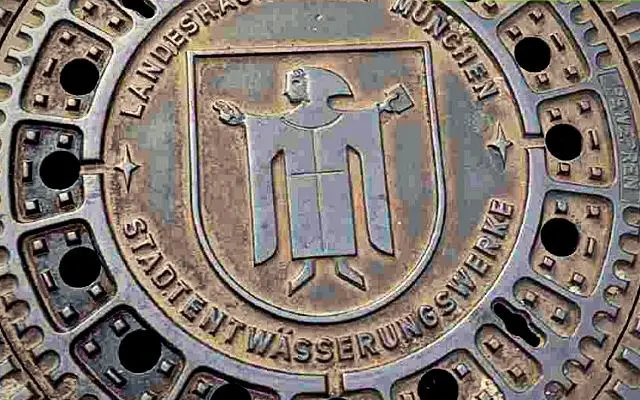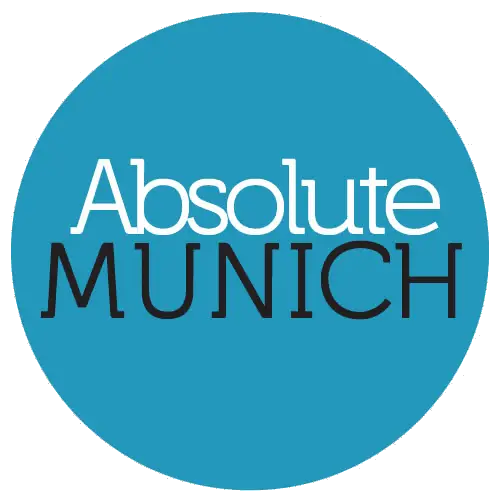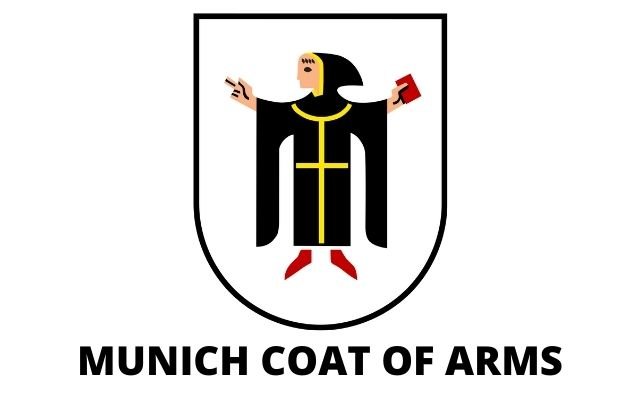The Munich Coat of Arms depicts a boy monk cloaked in black with gold trim, wearing red shoes, and holding a red book on a white/silver background.
Over the years since the crests inception, there’s been furious debate about what the monk is holding in his left hand with most believing it’s a local code of law book, whilst others believe it to be a bible.
The monk’s right hand is outstretched as if taking an oath or giving a blessing, so it’s entirely plausible that it could be either of these supposed items.
München, the German word for Munich, basically means “of monks”. Therefore, the monks vestige on the coat of arms is likely a play on the city’s past heritage when the city was actually full of monks.
History of The Munich Coat of Arms
The Munich Coat of Arms (The Münchner Wappen), with its distinctive monk motif, dates back to medieval times when it was used as the actual official seal of Munich. The town’s administration would use this seal as proof of the town-councils authenticity on official council documentation.
Interestingly, the seal has been altered and changed a number of times over the years but finally, in 1957, the current form of the City of Munich Coat of Arms was officially adopted and has been in use ever since.
During the reign of King Max I (1806-1825), the seal was altered constantly with various additions (and deletions) being made to the crest. At various times it has included a royal crown (or two), a golden lion, a sword, a shield, Joseph, and the letter ‘M’.
The reign of the NSDAP political party between 1936 and 1945 saw the Munich Coat of Arms appear with an eagle over the city gates holding the infamous Swastika in its talons.
It’s said the Coat of Arms was changed to show the city’s move away from the control of the monks in the first instance but due to outrage by the local population, the Munich Coat of Arms was restored to its traditional boy monk courtesy of ratification by King Ludwig I in 1834.
Although the Munich Coat of Arms has seen changes over the years, since 1957, it has remained the same image of the boy monk in a black cloak and red shoes holding a red book.

What Is The Münchner Kindl ?
It was in the 19th Century that the term Münchner Kindl was first documented as describing the youthful monk that adorns the Munich Coat of Arms.
Whilst the young monk had been a part of the coat of arms since the 13th century in one guise or another, it wasn’t until the 1800’s that the figure became much more youthful-looking than its past variations.
Münchner Kindl translates in German as Munich Child, and whilst currently, it appears to be a young boy, it hasn’t always been so having appeared as a gender-neutral child, a girl and also as an older male.
There have been many variations on the Münchner Kindl displayed on all sorts of Munich related touristic wares, from Mugs and Beer Steins to T-shirts and Spoons. The Munich Child has also regularly been a popular motif used by companies and businesses throughout Bavaria as well.

Does Munich Have Two Different Coat of Arms?
Yes, Munich does have two differing Coat of Arms, but they are actually large and small variations of the exact same coat of arms.
The large Munich Coat of Arms depicts the Münchner Kindl standing beneath the gates to Munich City with the lion motif proudly sitting above the gates. This large Coat of Arms is now utilised by the Munich City Council and the administration of the State of Bavaria only for special “representative” purposes.
The small Coat of Arms featuring just the Münchner Kindl on its own, is the official version utilised on a day-to-day basis and is the version you’ll see prominently displayed about the city.
We hope you enjoyed learning more about this small yet interesting part of Munich History.
We’ll add sections soon on the Bavarian Coat of Arms and also the House of Wittelsbach Coat of Arms to complete the Munich City Coat of Arms “Trifecta”.
Taking a Walk Around Munich you’ll see the Coat of Arms displayed on all manner of buildings, doorways, arches, street tiles/manholes, churches and all manner of other places so keep an eye out!
And if you do spot the Munich Child out and about on your travels, why not let us know in the comments below exactly where you found him.
Cheers and thanks for reading!
Prost und danke fürs Lesen

